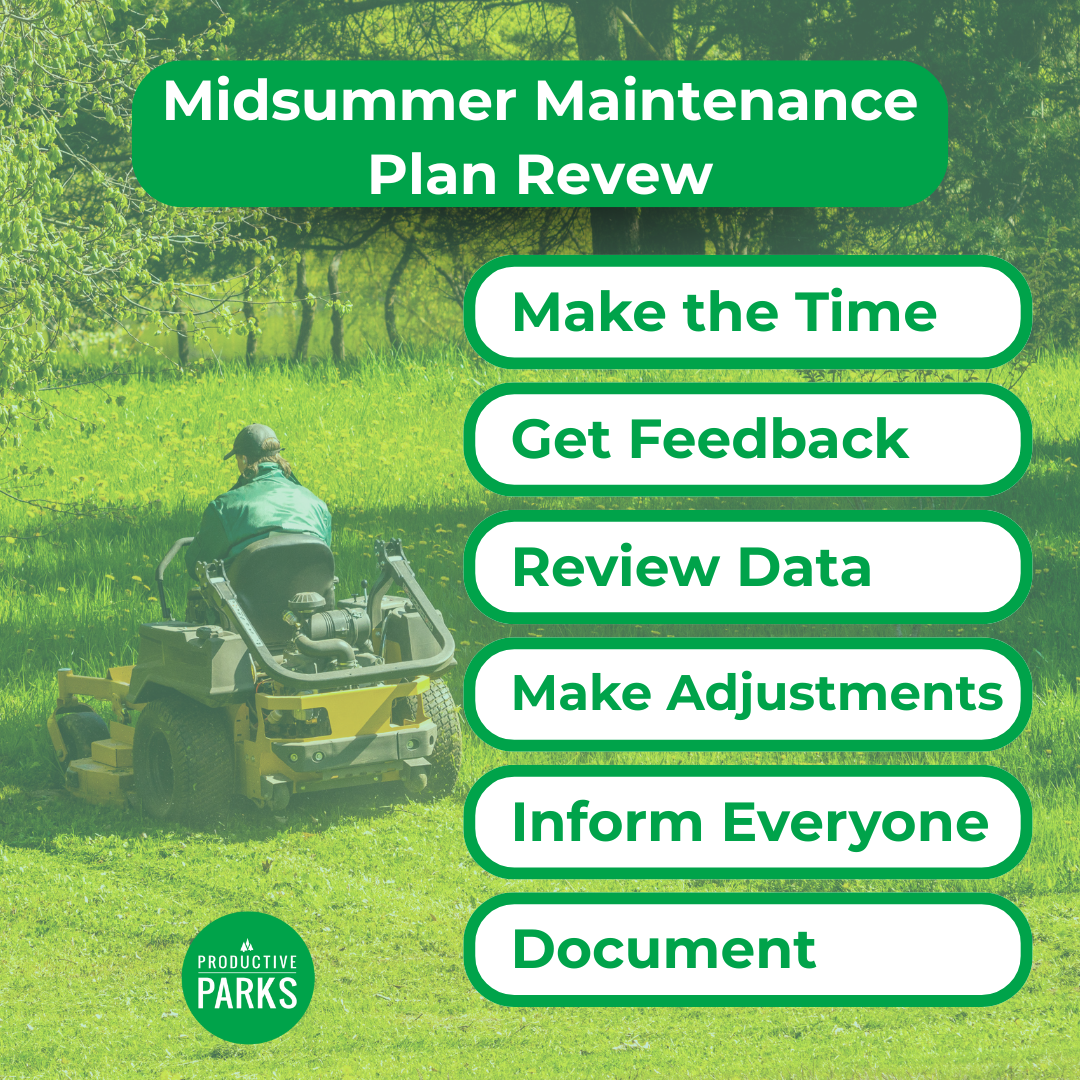
There is often a (very) brief period towards the middle of summer where your team gets a respite from everything happening over the last couple of months. As we all know, it doesn’t last long, but it provides an opportunity that should not be ignored.
Using a midsummer lull to review and adjust your maintenance plan may seem like a daunting task. But it doesn’t have to be. If you break the steps down and create a plan for the evaluation, you can use your limited time wisely to ensure your maintenance team is operating at its best for the second half of the growing season.
In this article, get the steps and insights to briefly pause and evaluate your maintenance program midseason. Then get some tips on how to roll out the changes and adjustments.

Make the Time
This may seem obvious, but actually blocking out the time is the foundation for a maintenance plan review. Make this a dedicated time that is non-negotiable except for the most pressing emergencies.
We all know how easy it is to put off non-essential work this time of year. But it’s important to come in with the mindset that this midsummer maintenance evaluation is essential. After all, the input and troubleshooting could make things easier and smoother for your maintenance team for the rest of the growing season.
Coordinate calendars and schedule meetings with your supervisors and other key staff. Develop an evaluation framework to use at the meetings and check-ins. The framework should include objectives you want to focus on, the type of information you want to get from your team, and what data you want to collect.
Get Feedback
Now that you have the time blocked out to meet with your team, find out how things are going from your team’s perspective.
Give the maintenance team and other stakeholders the opportunity to talk about how things went. Get their input on things like:
- What’s working and efficient?
- What’s causing the most stress?
- What can be changed to improve processes and workflows?
- What does the staff wish was done differently in the department?
- Any new ways to address complicated tasks?
- Is anything getting overlooked or ignored?
Discuss things you’ve heard during the last couple of months. Bring up the challenges the team faced and how they reacted to them.
Gather as much information as you can from different sources. Keep things open-ended and take note of any solutions or ideas coming from the meetings. Consider anonymous surveys or comment cards for those who feel more comfortable remaining unidentified while sharing their thoughts.
Hearing the different perspectives may give you a new take on an old or recurring problem. Some fresh thoughts on old routines can also inspire you to make changes you never considered.
Also, be sure to celebrate the successes and hard work of the park maintenance team during this busy time. Even simple tokens of appreciation and acknowledgement can help boost a maintenance team’s morale.
Review Data
Review any data you collected to see if you are reaching your key performance indicators (KPIs). For example, you may have goals set for how long it takes to complete work orders, preventative maintenance vs reactive maintenance, or the percentage of passing routine inspections.
Evaluating data could include reviewing inspections, tallying up information on spreadsheets, or getting reports generated from your maintenance management software. For example, using maintenance management software, you can pull up the average time it takes to mow at each of your parks and use that information to construct more efficient routes.
Make Adjustments
Determine the highest priority needs and fixes, and start troubleshooting. Review your staff feedback and available data. See what adjustments can be made. Can the issues be addressed with different staffing patterns, new equipment, or changes in standard operating procedures?
It’s still a busy time of the year, so rolling out major changes can be difficult. Determine if any upcoming projects or special events will affect these adjustments. For example, a late summer festival may require a couple of weeks where you have to redistribute resources to help with the special event.
You may not have the time and bandwidth to address every issue. Still, a couple of “small wins” by tweaking your schedules or plans could help with the maintenance team’s efficiency.
Get Everyone Up to Speed
Once you’ve decided on the changes, make sure your entire team knows about them. Hold a short in-service, have documentation readily available, and follow up with staff as the changes are being implemented.
Change isn’t always easy, so keep encouraging your team as they make the adjustments. Get input from the team as you roll out any additional plans. Every suggestion your team makes may not be feasible, but acknowledge their concerns and ideas.
Document Changes for Future Planning
Finally, make sure you document any changes you made midseason, so you can work them into next year’s planning. A lot is going to happen between now and next spring, so you want to make sure you have easily accessible records when you need to start planning for next year.
This documentation will also serve as a useful guide for future staff and maintenance managers as a record of what was working and what wasn’t working well in your department.
The Takeaway
Spring and early summer are hectic times for a park maintenance department. If your team has a week or two to catch their breath, this is an excellent opportunity to check how things are going and make some adjustments to improve performance.
By getting feedback, reviewing available data, and clearly communicating the desired changes, your team has a chance to be even more productive in the second half of the summer.
